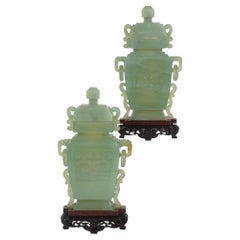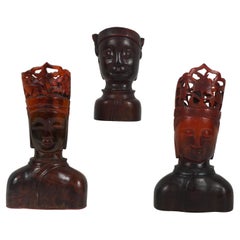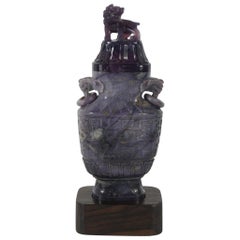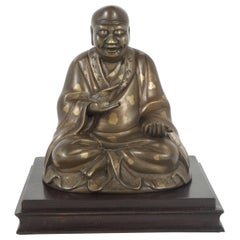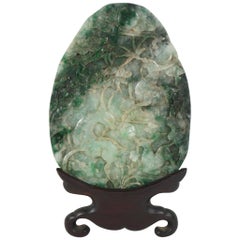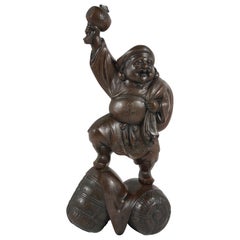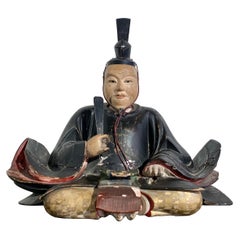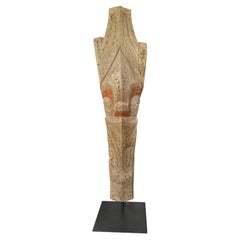Gottlieb Gallery Sculptures and Carvings
to
14
14
8
6
4
2
8
7
4
4
4
14
13
11
1
1
14
14
14
Pair of 20th Century Chinese Carved Bowenite Lidded Urns.
Located in Hudson, NY
This nice pair of carved lidded urns are made form Bowenite which is considered a semiprecious stone and thought to resemble jade. They were carved in the mid 20th century and come w...
Category
Mid-20th Century Chinese Sculptures and Carvings
Materials
Stone
Three Early 20th Century Red Horn Carvings of Buddha and Bodhisattva
Located in Hudson, NY
Three early 20th century red horn carvings of Buddha and Bodhisattvas. These three carvings all from approx. circa 1915 represent the bodhisattvas and or the ...
Category
Early 20th Century Chinese Busts
Materials
Horn, Rosewood
Chinese Republic Period Carved Amethyst Quartz Vase with Cover
Located in Hudson, NY
This urn, while archaistic in shape, generally is far more typical of 18th and 19th century specialty carved hardstone vases. The carving in rich veined amethyst quartz was done circa 1930-1940 and is dominated on the lid with a Kylin or mythical beast that in Chinese culture represents good luck and prosperity. The lid its self is ribbed and rests on the top of the urn between two further Kylin heads holding in there mouth loose rings. The main body of the vase is covered in Taotie masks in a stylized form. The foot of the urn, as well as the shoulder above the main body, are carved with lambrequins inset with traditional Chinese repetitive patterns often found on ancient dynastic...
Category
Mid-20th Century Chinese Sculptures and Carvings
Materials
Amethyst
Late 19th Century Chinese Gold Fleck Cast Bronze Figure of Buddha
Located in Hudson, NY
This work cast in bronze with a gold fleck finish to the clothing was made in the last quarter of the 19th century. The patina and color of the figure has lovely rub through and sits...
Category
Antique Late 19th Century Chinese Sculptures and Carvings
Materials
Bronze
Early 20th Century Chinese Qing Dynasty Large Jadeite Carved Plaque on Stand
Located in Hudson, NY
This very nice carved plaque of good size comes from China and was made circa 1900. The stone is a rich combination of dark, light and emerald green. Sliced from a boulder washed and...
Category
Early 20th Century Chinese Qing Sculptures and Carvings
Materials
Jade
19th Century Japanese Silver Inlayed Bronze Representing Daikoku
Located in Hudson, NY
From the Estate of Paul & Clara Kellner. This large bronze of Daikoku or the God of Prosperity closely associated with farmers, agriculture and rice staples of Japanese life and stability. His attributes are a co-mingling of Indian Buddhist forms of Shiva and the Shinto God...
Category
Antique Late 19th Century Japanese Sculptures and Carvings
Materials
Silver, Bronze
19th Century Tibetan Patinated Bronze Figure of Tara on New Black Base
Located in Hudson, NY
This fine old bronze of Tara was made for the purpose of focusing on the process of meditation regarding her aspects of wisdom and compassion. Crafted in Tibet but nearer to India and its influences this figure is an interesting combination of Hindu and Buddhist art and religion. Originally Tara was conceived as a Hindu mother goddess with the spread of Buddhism she was redesigned sometime after 4th century giving her a new role within the spreading Buddhist religion. This seems to have taken place in Shri Lanka and then spread out and back into India and Tibet thru China. At this time Shri Lanka was a great trading center and was host to many religious aspects, sects and ideals. The figure is cast with many fine details and is patinated in a warm green, brown showing traces of a coppery red color. The bronze content of this figure has a high amount of copper in the smelting giving the bronze a rich internal red color. Seated in lalitasana with her pendent right foot resting on a separately cast Padma or lotus pillow...
Category
Antique Mid-19th Century Tibetan Tibetan Sculptures and Carvings
Materials
Bronze
Early 19th Century Chinese Carved Agate Urn Set on a French Gilt Base
Located in Hudson, NY
This fine Chinese urn carving from the early 19th century has been in the late 19th century placed on a carved wood base that has been gilded creating a dramatic foil for the carving...
Category
Antique Early 19th Century Chinese Qing Sculptures and Carvings
Materials
Agate
Late 19th Century Chinese Glazed Terracotta Seated Luohan Figure
Located in Hudson, NY
This hand-shaped and incised terracotta Luohan or seated figure of a scholar was made in China at the end of the imperial dynastic period circa 1900. Luohan or a term for an Arhat who are the historical disciples of the Buddha. These figures have been seen throughout Buddhistic artist tradition for as long as the Buddhas religious teachings have existed. The figure seated on a rock rests...
Category
Antique Late 19th Century Chinese Qing Sculptures and Carvings
Materials
Terracotta, Wood
Late 19th century Carve Stone Cambodian Buddha
Located in Hudson, NY
This sage green carved stone Buddha was purchased from an upstate NY garden where it has resided for the last 120 years. The family began the house and garden in the late 1890s and traveled through China, Southeast Asia and Europe acquiring objects to create a complete retirement home for themselves and their family from New York City. Sculptures like this are a typical form found at Angkor of numerous sizes representing Nagas and used as guardians of temples. This figure was a favorite motif of Angkorean sculptors from the 12 century...
Category
Antique 1890s Cambodian Other Sculptures and Carvings
Materials
Stone
Late 19th/Early 20th Century Carved Jade Mythical Bird Carving
Located in Hudson, NY
This nicely carved bird figure is done in an 18th-century style but is from the very late 19th century to early republic period. The stone is a soft mellow celadon green with dark br...
Category
Early 20th Century Chinese Sculptures
Materials
Jade
19th Century Chinese Bronze Dancing Figure
Located in Hudson, NY
The charming figure done completely in the lost wax method is in a primitive naive style. The male figure is dancing excitedly on a rocky outcrop. His costume of a loose-fitting coat with long flared sleeves flying in space as he dances reveals his large potbelly while his loose-fitting shift girdled at the waist with a large belt flips up to show his legs and bare feet as he dances. The figure is suspended on one leg as he moves and his face is animated and happy. The head is cast separately so that his wild hair and beard are free from the body castings...
Category
Antique 19th Century Chinese Sculptures
Materials
Bronze
19th Century Nephrite Jade Carved Plaque on Stand
Located in Hudson, NY
This carved Nephrite Jade plaque of a mythical best has the attributes of a dragon and a fish leaping from the water. Carved we believe in the late 18th or early 19th century to be u...
Category
Antique 19th Century Chinese Sculptures
Materials
Jade
Late 19th or Early 20th C. Carved Jade Urn
Located in Hudson, NY
This fine jade urn of a lovely spinach color running to a deep yellow is carved to resemble a pair of Buddhist lions or mythical beasts conjoined back to back...
Category
Early 20th Century Chinese Urns
Materials
Jade
Related Items
Japanese Carved and Lacquered Wood Shogun, Edo Period, 19th Century, Japan
Located in Austin, TX
An unusual Japanese carved wood, lacquer, and gilt decorated portrait sculpture of a shogun, Edo Period, early 19th century, Japan.
The unidentified shogun (possibly Tokugawa Iey...
Category
Antique Mid-19th Century Japanese Edo Sculptures and Carvings
Materials
Wood, Lacquer
$2,800
H 10.25 in W 10.5 in D 7.5 in
Singa Guardian Sculpture from the Batak Tribe of Sumatra, Early 20th Century
Located in Jimbaran, Bali
A Batak Tribe “Singa” from the Indonesian island of Sumatra. This mythical lion figure was used as a protective architectural element on the corner of a traditional Batak house. It f...
Category
Early 20th Century Indonesian Other Sculptures and Carvings
Materials
Wood
$2,080
H 57.09 in W 15.36 in D 14.57 in
Large Chinese Carved Nephrite Jade Double Buddha's Hand Vase, Late Qing Dynasty
Located in Austin, TX
A large and graceful carved nephrite jade conjoined double vase in the form of a pair of Buddha's hands fruit (finger citron), late Qing Dynasty, circa 1900, China.
The large and heavy vase carved from a single piece of celadon nephrite jade, with areas of lighter brown "sugar" skin. The vase ingeniously carved as a pair of Buddha's hand fruit, also known as finger citron, rising from a gnarled, leafy branch. The smaller Buddha's hand with a pair of bats. The Buddha's hands fruit with elegant and naturalistic curved "fingers". The "fingers wonderfully shaped and reticulated. The body of the fruit with simple stippling, in imitation of the textured surface of the real fruit. The interior of each fruit well hollowed and able to hold water.
Buddha's hands fruit are auspicious in Chinese culture. Their name in Chinese "Fo Shou" is a homophone for "Happiness and Longevity. They are often placed as offerings on Buddhist altars...
Category
Antique Early 1900s Chinese Qing Sculptures and Carvings
Materials
Jade
$9,800
H 8.75 in W 6.25 in D 3.5 in
Pair of Chinese Bronze Deity Figures, 20th Century
Located in Belmont, MA
Pair of Chinese bronze figures of deities standing on dragons. The two sculptures were made in the 20th century. They represent the Tao gods Lu Xing and Fu Xin...
Category
Vintage 1980s Chinese Chinese Export Sculptures and Carvings
Materials
Bronze
$1,000 Sale Price / set
47% Off
H 21 in W 8.5 in D 12.5 in
Chinese Jade Finely Carved Libation Cup, early Qing Dynasty.
Located in Sarasota, FL
Chinese light celadon jade libation cup from early 19th, possibly 18th century. The item is executed in archaistic Ming style.
Category
Antique Early 19th Century Chinese Sculptures and Carvings
Materials
Jade
Pair Chinese White Glazed Guanyin, Qing Dynasty, 18th Century, China
Located in Austin, TX
A sublime and rare pair of Chinese white glazed porcelain figures of Guanyin, attributed to Tang Ying (1682 - 1756), Qing Dynasty, Qianlong Period, China.
This ethereal pair of white glazed porcelain figures depict the revered Buddhist Goddess of Mercy, Guanyin. Guanyin is portrayed standing, wearing heavy robes that drape beautifully around her figure. Bare feet peek out from under the hem of the robes. Her hair piled in a high chignon and covered by a cowl. The treatment of the hair, finely textured, unglazed, and with remnants of darker pigment, is typical of works by Tang Yin (1682 - 1756), who was the head of the imperial porcelain works at Jingdezhen.
Guanyin's beatific face is set in a serene smile, with a small, flat nose, and downcast, heavily lidded, almond shaped eyes. A simple beaded necklace graces her chest. Her hands held out, and may have once held attributes.
The hands were originally removable, but have since been permanently attached.
The figures crafted of a fine porcelain and glazed all over in a supple white glaze.
One figure bears a label from the Rafi Mottahedeh collection to the back.
Provenance:
Chinese Porcelain Company...
Category
Antique 18th Century Chinese Qing Ceramics
Materials
Porcelain
$21,000 / set
H 13.25 in W 5 in D 4 in
Early 20th Century Antique Chinese Carved Stone Buddha Head Sculpture
Located in Pomona, CA
This magnificent Chinese Antique Carved Stone Buddha Head was handcrafted dated back to 1900s and shows very detailed hand carving works on it. You can see from the pictures that It ...
Category
Early 20th Century Chinese Chinese Export Sculptures and Carvings
Materials
Stone
$1,290
H 16.5 in W 7.5 in D 8 in
20th Century Chinese Pair of Bronze Tang Horses/War Horses
Located in Pomona, CA
Elevate your home decoration with this this Stunning pair of vintage Tang Dynasty style Emperor/War horses. Each piece stands as a testament to intricate ...
Category
20th Century Chinese Chinese Export Sculptures and Carvings
Materials
Bronze
Model of Chinese Beauty Pink Rose Quartz Goddess Quan Yin Hand Carved Figurine
Located in Tustin, CA
Exquisitely hand made and hand carved pink rose quartz figurine of the goddess Quan Yin. She is depicted holding a festoon of lotus blossoms and ...
Category
Mid-20th Century Chinese Chinese Export Sculptures and Carvings
Materials
Rose Quartz
$495
H 10 in W 3.5 in D 2 in
Early 20th Century Antique Chinese Carved Faux Ivory Foo Dogs, a Pair
Located in Pomona, CA
In these matching pair of male and female lion/foo dogs with curling mane and bulging eyes, the female holding its cub beneath one paw; the male with an embroidered ball. Each wears ...
Category
Early 20th Century Chinese Chinese Export Sculptures and Carvings
Materials
Bone
$3,500
H 9 in W 3.25 in D 3.5 in
Early 20th Century Chinese Carved and Painted Wood Carved sitting Guan-Yin
Located in Pomona, CA
The image displays a statue of Guanyin, also known as Avalokiteshvara, a widely worshiped bodhisattva of compassion in Buddhism. It was made of camphor wood which has long history in...
Category
Early 20th Century Chinese Chinese Export Sculptures and Carvings
Materials
Wood
$1,370
H 19 in W 9 in D 6.5 in
Late 19th C. Granite Buddha Head, North India
Located in Nantucket, MA
A late 19th C. granite Buddha head on wooden base. Utttar Pradesh, Northern India. The hand-carved features include the typical snail-shell curled...
Category
Antique Late 19th Century Sculptures and Carvings
Materials
Granite
